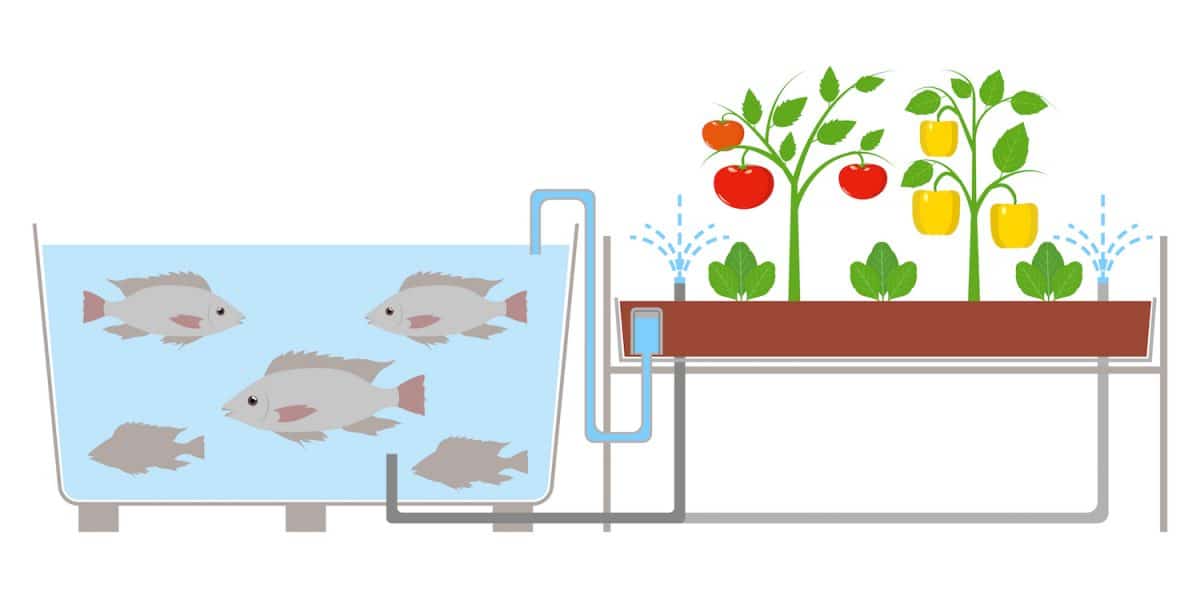 Aquaponics, how to produce plants and fish in a sustainable way. Shutterstock
Aquaponics, how to produce plants and fish in a sustainable way. ShutterstockCan you imagine raising fish under your urban garden? This is the proposal of aquaponics, to integrate fish farming to save 90% of water and eliminate, at the same time, the use of toxic chemicals. A system under development for private and industrial use.
Contents
What is aquaponics?
The term aquaponics is derived from the combination of the words ‘aquaculture’ (production of aquatic organisms) and ‘hydroponics’ (production of plants without soil). It’s a sustainable plant and fish production system.
Literally, aquaponics puts fish to work. It turns out that the work that fish do – eating and producing waste – is the perfect fertilizer for growing plants. And man, fish can grow a ton of plants when they get to work!
One of the coolest things about aquaponics is that it mimics a natural ecosystem.
Aquaponics represents the relationship between water, aquatic life, bacteria, nutrient dynamics and plants growing together in waterways around the world. Drawing inspiration from nature, aquaponics harnesses the power of biointegration of these individual components: Exchanging fish waste as food for bacteria, which becomes the perfect fertilizer for plants, to return water cleanly and safely. fish safety.
Just like mother nature does in all aquatic ecosystems.
How does aquaponics work?
The system is as follows: the fish produce compost or fertilizer from the soil, once they have expelled the nutrient-rich waste products from their diet. In other words, people feed fish so that they can then feed people. The circle of life.
Thus, the natural “fertilizer” expelled by the fish is pumped upwards, where it is absorbed by the plants. At the same time, the roots purify the water by removing these nutrients, which then flow back down to the fish. In this way, it is not necessary to introduce clean water every week.

This system saves up to 90% of water compared to conventional agriculture and completely eliminates any waste that may be generated, since it is a closed system. Systems of this type already exist today both for home production and for production on an industrial scale.
A home aquaponics system can be installed in an urban environment, in an open space of the house, on a balcony, which receives at least 5 hours of sunlight per day. Large-scale commercial aquaponics systems are also easy to manage and the farmer has little to control, both in crop and fish production. Vegetables, such as lettuce, can be harvested after four to six weeks of the short cycle.
A technique with a story.
The Integrated Fish and Vegetable Farming System technique actually mimics the natural nutrient cycle in any small-scale ecosystem. This is not new: aquaponics was already known and used thousands of years ago by civilizations as disparate as the Aztecs or the Chinese.
What fish to use in aquaponics?
The fish used in aquaponics are generally tilapia, a very resistant species capable of supporting high population densities. Although the truth is that the system hosts all kinds of freshwater fish. Important: This system works best in warm climates.
Equipment for aquaponics.
For a home aquaponics system, the following items are needed: a pond for raising the fish; a pump, responsible for transporting water with the nutrients of peace upwards, where the hydroponics is located; gutters where we will plant our garden, a pipe through which the solution circulates and a filtering system so that the pipes are not clogged.
As for the substrate that we will use in this type of orchard, it will be gravel that can cover different sizes. Irrigation must be continuous, drip and other irrigation systems generally do not work well.
The best thing about aquaponics is that it is totally eco-friendly, we have already got a non-polluting fertilizer which is also totally natural.
Basic rules to follow in aquaponics.
By following a few basic rules, you will be able to assemble and maintain your own system without any problem.
- The tank is very important. Aquariums are a very important choice in aquaponics. Any tank can work for you, but using a round tank with a flat or tapered bottom will make your life easier as they are easier to clean.
- Aeration and circulation of fundamental waters. Consider using water and air pumps to ensure the water has high levels of dissolved oxygen and good water movement so your animals, bacteria and plants stay healthy. Use photovoltaic energy when possible, as any power outage can be fatal to your system.
- Water quality is crucial. Water is vital in an aquaponics system. It is the means by which all essential nutrients are transported to plants and where fish live. There are five important water quality parameters to monitor and control: dissolved oxygen (5 mg/litre), pH (6-7), temperature (18-30°C), nitrogen total and water alkalinity.
- Do not overfill the tanks. The recommended density is 20 kg/1000 litres, which leaves a substantial growth area for the plants.
- No to overeating. Feed the fish daily, but remove any uneaten food after 30 minutes and adjust the next day’s portion accordingly.
- Choose and space the plants well. Leafy green vegetables work very well in aquaponics, as well as some of the more popular fruiting vegetables, such as tomatoes, cucumbers and peppers.
- Good balance between plants and fish. Having a secure source of young plants and fish is important, so be sure to consider supply in your planning phase.
Management of an aquaponic system.
Achieving system balance, maintaining it and ensuring optimal conditions for fish and plants requires close control of various parameters.
The main production parameters that must be perfectly adjusted to meet the optimal needs of plants and fish are:
- Air temperature.
- The water temperature.
- The concentration of macro and micronutrients.
- Dissolved oxygen in air and water, which depends on the filtration method used.
- CO2 concentrations in air and water.
- The pH.
- The light.
The more “optimal” these parameters are, the higher the productivity of the system.
Paying attention to these details can help prevent insects, disease and other types of contamination.
In addition, maintaining a good balance between fish waste and the nutrient demand of vegetables, while providing a suitable surface for the growth of a bacterial colony which converts all fish waste.
How to make a homemade aquaponics system.

Although in English, here you have a very complete manual on aquaponics.
Benefits of aquaponics.
According to the FAO, there are many inherent benefits of adopting a system design such as aquaponics to grow food. What are the benefits of aquaponics?
- It allows for a sustainable intensive food production system.
- It encompasses two agricultural products (fish and vegetables) that are produced from a single source of nitrogen (fish feed);
- Aquaponics is an extremely efficient system in the use of water. You only need one-sixth the water to grow 8 times more food per acre compared to traditional farming.
- It does not need soil and is therefore not susceptible to soil-borne diseases.
- Aquaponics does not require the use of toxic chemical fertilizers or pesticides.
- Superior yield and qualitative production.
- Aquaponics involves a higher level of biosecurity and lower risks from external contaminants.
- It allows better control (since it is easier than soil control) over production, resulting in fewer losses.
- Aquaponics can be used on non-arable land, such as deserts, degraded soils or salty and sandy islands.
- It generates little waste because it mimics nature’s circular approach;
- Aquaponics can integrate livelihood strategies to provide food and small incomes to poor and landless households.
- It creates fish protein, a valuable addition to many people’s dietary needs.
- Aquaponics is an all-natural process that mimics all lakes, ponds, rivers and streams on Earth.
- Nutritionally, aquaponics provides food in the form of protein (from fish) and vegetables.
Weaknesses of aquaponics.
Each coin has two sides. And based again on the FAO report, we can also find some weak points that come with adopting an aquaponic design.
- High initial start-up costs (compared to hydroponic or soil-based production systems);
- Aquaponics requires a deep understanding of the natural world. To be successful, farmers must know not only how to grow vegetables, but also how fish and bacteria work. And technical knowledge about plumbing or wiring is also required.
- It is often difficult to find a perfect match between the needs (such as pH, temperature, substrate) of fish and plants.
- Aquaponics has fewer management options than stand-alone aquaculture or hydroponics.
- Errors in the management of the system can quickly lead to its collapse.
- Day-to-day management is required, which means organization is crucial.
- May have high energy costs.
- Fish feed should be purchased regularly.
- Aquaponic products alone are not enough to guarantee a balanced diet.
- You must have effective filtering of organic solids, which is the function of bacteria or algae. More than two-thirds of aquaponic system failures are due to inefficient solid waste disposal.
Potential uses of aquaponics.
According to the FAO, aquaponic systems are made up of units that can come in different shapes and sizes.
From small appliances on kitchen benches with goldfish and herbs, to larger systems that grow largemouth bass and lettuce.
On an industrial scale, the most complex units can also produce tons of fish and thousands of plants per month.
Current applications of aquaponics:
- Home or small-scale aquaponics system. It is an aquarium of about 1000 liters and a culture space of 3 m2, ideal for home production.
- Semi-commercial and commercial aquaponics. It’s about looking at an aquaponics system from a perspective where there aren’t many players in the market yet due to high start-up costs.
- Education. Small aquaponic units are being used in schools to bridge the gap between the general public and sustainable farming techniques.
- Humanitarian aid and food security. As aquaponic systems operate all over the world, they can be used as pilots in developing countries to meet the food security needs of local populations.
Source: fao.org
